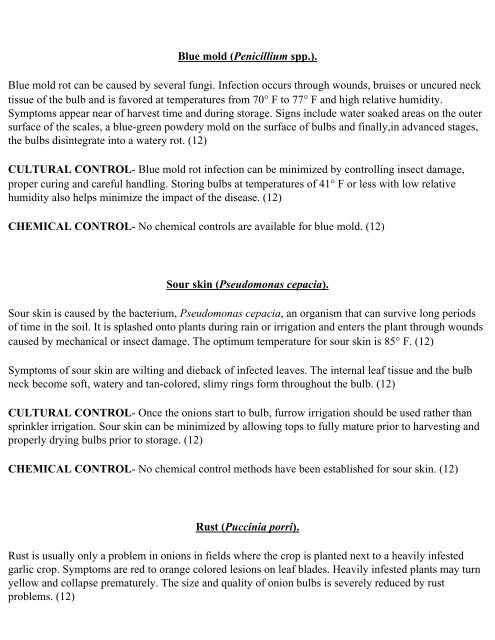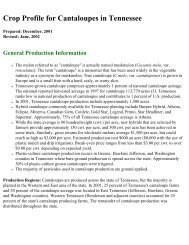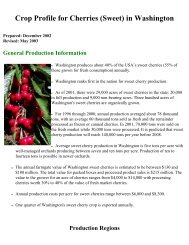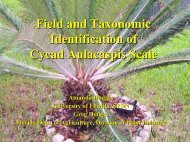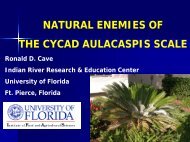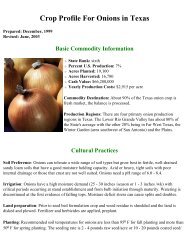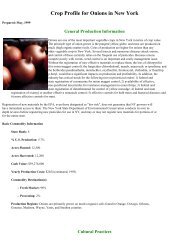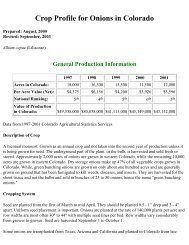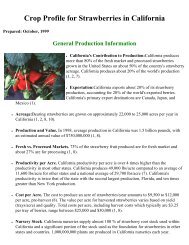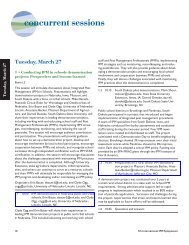Crop Profile for Onions in California - Regional IPM Centers
Crop Profile for Onions in California - Regional IPM Centers
Crop Profile for Onions in California - Regional IPM Centers
Create successful ePaper yourself
Turn your PDF publications into a flip-book with our unique Google optimized e-Paper software.
Blue mold (Penicillium spp.).<br />
Blue mold rot can be caused by several fungi. Infection occurs through wounds, bruises or uncured neck<br />
tissue of the bulb and is favored at temperatures from 70° F to 77° F and high relative humidity.<br />
Symptoms appear near of harvest time and dur<strong>in</strong>g storage. Signs <strong>in</strong>clude water soaked areas on the outer<br />
surface of the scales, a blue-green powdery mold on the surface of bulbs and f<strong>in</strong>ally,<strong>in</strong> advanced stages,<br />
the bulbs dis<strong>in</strong>tegrate <strong>in</strong>to a watery rot. (12)<br />
CULTURAL CONTROL- Blue mold rot <strong>in</strong>fection can be m<strong>in</strong>imized by controll<strong>in</strong>g <strong>in</strong>sect damage,<br />
proper cur<strong>in</strong>g and careful handl<strong>in</strong>g. Stor<strong>in</strong>g bulbs at temperatures of 41° F or less with low relative<br />
humidity also helps m<strong>in</strong>imize the impact of the disease. (12)<br />
CHEMICAL CONTROL- No chemical controls are available <strong>for</strong> blue mold. (12)<br />
Sour sk<strong>in</strong> (Pseudomonas cepacia).<br />
Sour sk<strong>in</strong> is caused by the bacterium, Pseudomonas cepacia, an organism that can survive long periods<br />
of time <strong>in</strong> the soil. It is splashed onto plants dur<strong>in</strong>g ra<strong>in</strong> or irrigation and enters the plant through wounds<br />
caused by mechanical or <strong>in</strong>sect damage. The optimum temperature <strong>for</strong> sour sk<strong>in</strong> is 85° F. (12)<br />
Symptoms of sour sk<strong>in</strong> are wilt<strong>in</strong>g and dieback of <strong>in</strong>fected leaves. The <strong>in</strong>ternal leaf tissue and the bulb<br />
neck become soft, watery and tan-colored, slimy r<strong>in</strong>gs <strong>for</strong>m throughout the bulb. (12)<br />
CULTURAL CONTROL- Once the onions start to bulb, furrow irrigation should be used rather than<br />
spr<strong>in</strong>kler irrigation. Sour sk<strong>in</strong> can be m<strong>in</strong>imized by allow<strong>in</strong>g tops to fully mature prior to harvest<strong>in</strong>g and<br />
properly dry<strong>in</strong>g bulbs prior to storage. (12)<br />
CHEMICAL CONTROL- No chemical control methods have been established <strong>for</strong> sour sk<strong>in</strong>. (12)<br />
Rust (Pucc<strong>in</strong>ia porri).<br />
Rust is usually only a problem <strong>in</strong> onions <strong>in</strong> fields where the crop is planted next to a heavily <strong>in</strong>fested<br />
garlic crop. Symptoms are red to orange colored lesions on leaf blades. Heavily <strong>in</strong>fested plants may turn<br />
yellow and collapse prematurely. The size and quality of onion bulbs is severely reduced by rust<br />
problems. (12)


